Knowledge
Success Leave Clues
Articles, Strength and performance
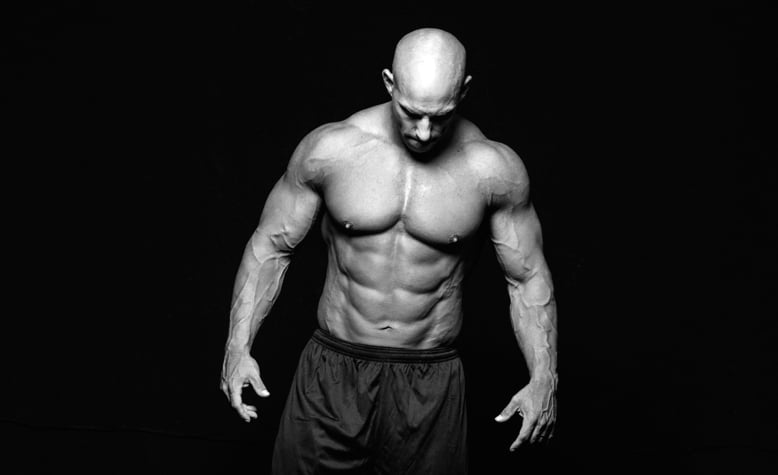
Success Leave Clues
I like to look up to the most successful barbell athletes for clues about what works best to build muscle and strength. For example, I asked my friends Jean-Francois Caron and Jimmy Paquet (the two strongest men in Canada) about their training success and wrote an article about it here: 5 Things I Learned from the Strongest Gym In Canada
While it is undisputable that the top bodybuilders, powerlifters, strongman competitors and Olympic lifters have genetic gifts that we don’t have and that performance-enhancing drugs are an important part of the puzzle; when you look at what the tops are doing with an analytical eye you can still learn quite a few things.
Take bodybuilding for example. Yes, drugs play a big part in reaching pro-size. But I know plenty of gym rats who take huge doses of anabolics and do not look remotely close to pros. I also know pros who use a lot less drugs than you might think (or would love to believe).
I still like to look at different bodybuilders’ training programs to get some ideas about what is effective. Take Dorian Yates for example. Dorian is my all-time favorite bodybuilder. I love his thickness and the look of power he has. But it was mostly his workman-like approach and low-key personality that I admired about him.
Strictly from a bodybuilding perspective, Yates is known mostly for two things: his monstrous back and granite conditioning.
It is with his back development in mind that I analyzed the way he trained. To see if there are some clues about the best way to stimulate muscle growth back there, since it is my own worst area.
Of course, you can argue that he had a genetic predisposition for having a big back (like Ronnie Coleman had a predisposition for crazy biceps). But I don’t buy it, not 100%. When you look at pictures of him when he turned pro he had a decent back, but it didn’t stand out compared to his other body parts. And building a back is not like building biceps. If you are genetically gifted for biceps development and shape it’s one thing, one muscle. But to have a great back you need the develop a lot of different muscles: traps (upper, mid, lower), rhomboids, rear delts, teres minor, latissimus dorsi, erector spinea. Literally you would need to be “genetically gifted” in about 8 muscles to rely only on genetics to build a freaky back.
That’s why you see a lot of people with great “frontal” upper bodies, but few with great backs.
With that in mind, let’s look at Yates training split and “usual” exercises selection. With Yates, the cool thing is that he was very meticulous and didn’t vary his training once he adopted this program in 1992-1993. He would swap some exercises in and out depending on availability at the gym he trained at, but generally stuck to his guns.
As for his training style, we know that he would do a few build-up sets (the number depending on the exercise and how heavy he went) and did one all-out set to failure or beyond (forced reps, rest/pause, negatives, etc.). But that is not the main area of focus of my analysis.
Let’s look at his foundation: his training split.
It was as follow. Note that at the beginning of his career he used a slightly different approach, still low volume and lower frequency. But this was the split he used for his Mr. Olympia years.
DORIAN YATES TRAINING SPLIT
Day 1 – Chest & Biceps
Day 2 – Back & Rear Delts
Day 3 – OFF
Day 4 – Shoulders, Traps & Triceps
Day 5 – OFF
Day 6 – Legs
Day 7 – OFF
As you can see, the frequency of training days is fairly low, especially since training 6 days a week was the norm just before him. He was also a low volume guy. So, we can say that he was one of the first (Mike Mentzer, Casey Viator, Boyer Coe being pioneers in that regard) to focus on recovery as much as on training.
Recent studies have shown that for maximum hypertrophy you need to hit a muscle two or three times a week. Three being more effective than two. That doesn’t mean that you need to do specific exercises for each muscle 2-3 times a week, but that each muscle must be involved enough in some exercise to receive a stimulatory effect 2-3 times a week.
On the surface, Yate’s split would seem illogical since each muscle is trained only once a week.
But let’s dig a little deeper.
Here are Yates’ typical exercises for each of his workouts.
Chest & Biceps
Incline bench press
Chest press machine (was decline bench press earlier in his career)
DB flies
Cable cross-over
EZ bar standing curl
Incline DB curls
Single-arm machine curl
Back & Rear delts
Pullover machine
Lat pulldown machine
Bent over barbell row
Single-arm seated row machine
Rear delts (reverse flies) machine
Bent over lateral raise
Weighted back extensions
Deadlift
Shoulders, Traps & Triceps
Smith machine shoulder press
Seated DB lateral raise
Single-arm cable lateral raise
DB shrugs
Triceps pushdown
Lying EZ bar triceps extension
Single-arm triceps press down
Legs
Leg extension
Leg press
Hack squat
Lying leg curl
Stiff leg/Romanian deadlift
Standing calf raises
Exercise Selection And Back Development
We will start with Dorian’s back. After all, it was his marquee “region”.
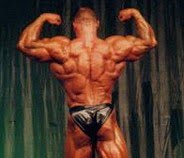
Look at this picture of his back in 1996. Nobody has ever reached that level of thickness, separation and completeness.
Here is his list of exercises again. I bolded all the exercises that put a significant stimulus on one of the part of the back.
Chest & Biceps
Incline bench press
Chest press machine
DB flies
Cable cross-over
EZ bar standing curl
Incline DB curls
Single arm machine curl
Back & Rear delts
Pullover machine
Lat pulldown machine
Bent over barbell row
Single arm seated row machine
Rear delts (reverse flies) machine
Bent over lateral raise
Weighted back extensions
Deadlift
Shoulders, Traps & Triceps
Smith machine shoulder press
Seated DB lateral raise*
Single-arm cable lateral raise
DB shrugs**
Triceps pushdown
Lying EZ bar triceps extension
Single-arm triceps press down
Legs
Leg extension
Leg press
Hack squat
Lying leg curl
Stiff leg/Romanian deadlift***
Standing calf raises
*I bolded the seated DB lateral raise, because even though it is a movement for the medial portion of the deltoids when you watch Dorian do it you can actually see that the rear deltoids are actually initiating the movement and receive a lot of stimulation.
Look at the video here: https://youtu.be/X8-1RTPUVfg?t=32s
**He does his DB shrugs using a technique that I call “old-time standing row” where he leans forward a bit and instead of just shrugging up with his traps he actually pulls with his arms, just like in a row. And he pulls slightly backwards. That style will obviously hit the upper traps very well (that’s how I do it) but it will also hit the mid traps, rhomboids and even some rear delts. As such it is actually a very good upper back exercise, not just a trap movement.

Look at the video here: https://youtu.be/X8-1RTPUVfg?t=1m29s
***The stiff leg/Romanian deadlift is of course primarily to hit the hamstrings and glutes. But it is a complete movement that also puts a lot of stimulus on the lower back (this is well known). But it also heavily involves the upper back (traps, rhomboids, rear delts, lats) since it is responsible for keeping everything in place (and the bar close to you) when pulling.
What we see is that Yates trained his back three times a week. Sure, not all of these sessions have a high amount of volume. But understand that Yates’ intensity was such that a few work sets were enough to stimulate growth.
Exercise Selection And Deltoids Development
In my opinion, Yates’ second, best body part was his shoulders. Round and full. Along with his huge traps, it gave his “yoke” area a look of power that few, if any, bodybuilders ever had.
If we look once again at his list of exercises and highlight the movements that stimulated one of the three parts of the deltoids we come up with:
Chest & Biceps
Incline bench press
Chest press machine
DB flies*
Cable cross-over*
EZ bar standing curl**
Incline DB curls**
Single arm machine curl
Back & Rear delts
Pullover machine
Lat pulldown machine
Bent over barbell row
Single arm seated row machine
Rear delts (reverse flies) machine
Bent over lateral raise
Weighted back extensions
Deadlift
Shoulders, Traps & Triceps
Smith machine shoulder press
Seated DB lateral raise
Single-arm cable lateral raise
DB shrugs
Triceps pushdown
Lying EZ bar triceps extension
Single-arm triceps press down
Legs
Leg extension
Leg press
Hack squat
Lying leg curl
Stiff leg/Romanian deadlift
Standing calf raises
Unless you are a total newbie, you know that any pressing exercise stimulates directly the three main pressing muscles (triceps, deltoids, pectorals). The angle of the press used will, of course, influence the ratio of effort that each of these muscles must provide; but anytime you press you will get some stimulation in the three main pressing muscles.
In that regard, the incline bench press, chest press machine and Smith machine shoulder press all hit the deltoids to a significant extent.
*While the cable cross-over and DB flies are seen as isolation exercises for the pectorals, it is false to assume that the deltoid is not involved. Specifically, I’m talking about the anterior (front) deltoid. DB flies are a movement called “transverse flexion” of the shoulder. And the anterior deltoid is one of the prime movers in that action.
And the way Dorian does his cable cross-over, there is also a strong transverse flexion component, which means that it also involves the anterior deltoid on top of the pectorals.
**Once again curl exercises are typically seen as pure biceps movement. But when there is movement at the shoulder joint (shoulder moving “forward”) it means that the anterior deltoid is involved. It’s called “shoulder flexion”: a movement where the upper arm rotates upward.
If you look at Yates doing barbell curls you can see that there is a small, but existent, shoulder flexion action. Which does involve the anterior deltoid.
Look at the video here: https://youtu.be/UHymqS5bZdg?t=1m58s
Note that in the past I advocated doing barbell curls without any shoulder movement to really isolate the biceps. I since then changed my views. While I do not cheat the weight up, I do use a slight shoulder flexion to initiate the barbell curl. I actually get a better biceps action this way (the biceps is also a shoulder flexor). It also allows me to use a little bit more weight. BUT for this to work you have to control the eccentric portion (lowering the weight) to create a greater overload.
I do not recommend an all-out cheat that takes the stimulus off of the biceps, but just enough to get the weight started, like Dorian is using in the video. I also use a perfectly strict form on exercises like preacher curls and machine curls.
He does the same on incline dumbbell curls, even more so when he nears failure.
I’m not saying that it makes the curl a great deltoid exercise, but they are still working. And if the intensity level is high enough, they can receive a training stimulus from it.
And, of course, anytime you pull, the rear deltoid will get stimulated. We can easily see that the deltoids are receiving some form of stimulus three times per week. If you want to focus mostly on the anterior and medial deltoids, then they are trained twice per week.
Exercise Selection And Chest
Dorian did have a pretty good chest., mostly his upper chest. I would put his back and delts much above his chest though. And if you look at his training the only times he hit his pectorals really is the chest & biceps day.
I will say that the Smith machine shoulder press can stimulate the upper chest (which might be why his upper chest was the best portion of his pectorals). Especially considering that Yates used a slight torso backward lean when doing that exercise. The slight backward lean (which I also recommend) allows you to use a little bit more weight and also involves the upper chest more than the more upright version.
Look at the video here: https://youtu.be/UHymqS5bZdg?t=1m58s
We can say that the clavicular portion of his pectorals is stimulated twice per week while the rest of the pectoral is hit once a week to a significant extent.
Exercise Selection And Arms
Looking at Yates’ arms can offset my analysis. His biceps were his worst muscle but that’s because he suffered a significant tear. The same thing happened to his triceps later in his career.
So yeah, we can say that Dorian’s arms were his weakness, but injuries certainly didn’t help.
But pre-injury his triceps were amazing and his biceps average.
In fact, his side triceps was arguably the best of all-time:
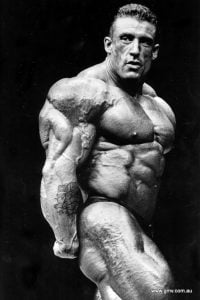
His triceps received two big stimulations per week. On the chest & biceps day, he did two heavy pressing movements that but a large stimulus on the triceps (incline bench press and machine chest press) and on his shoulders & triceps workout he obviously had his direct triceps work but also the shoulder press which heavily taxed the triceps.
As for his biceps, they were always his “weaker” upper body muscle, even pre-injury. Understand me: I’m not saying that his biceps sucked. I’m saying that compared to his other upper body muscles they were his weakest link… everybody has one!
Now, they did receive two stimulations per week, just like the triceps. They were hit directly with chest and also worked as a synergistic muscle during his pulling movements (lat pulldown machine, bent over row, single-arm row). As such you could argue that they should be the same level as all of his other muscles. But you have to dig deeper and look at how he did his reps on pulling exercises. My theory is that Dorian was a motor genius when it came to contract his back. As such it is not too much of a stretch to assume that the biceps mostly just went with the motion when pulling. This is the exact opposite of what you normally see: people are great at contracting their biceps but bad at using their back. As such when pulling the biceps work harder to bring the weight from point A to point B.
Another point that might be worth mentioning is that his forearms were massive. So, it is possible that the combination of forearm and back was responsible for most of the pulling, the biceps merely supporting everything and thus not being stimulated as much.
Exercise selection and lower body
Dorian had a granite-hard lower body. And it was perfectly balanced. But if you compare it to more modern standards you can see that his quadriceps were “lagging” a bit. Again, this is not a criticism: he had amazing legs overall but proportionally speaking his quadriceps were not as impressive as his hamstrings and glutes. They had good size but not as separated as other competitors for examples
His glutes were hard and massive (kinda weird to say that about another man!) and his hamstrings were very thick.
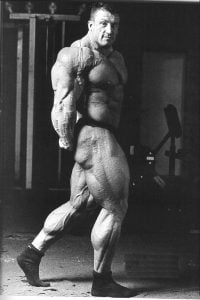
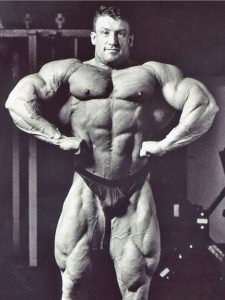
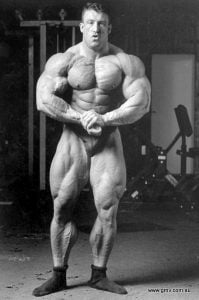
As far as development goes we could put his lower body muscles in this order:
- Calves (some of the best ever)
- Glutes
- Hamstrings
- Quads
And if we look at his training program one last time we can see that the quads get hit once a week and the hamstrings and glutes do get stimulated twice:
Chest & Biceps
Incline bench press
Chest press machine
DB flies
Cable cross-over
EZ bar standing curl
Incline DB curls
Single arm machine curl
Back & Rear delts
Pullover machine
Lat pulldown machine
Bent over barbell row (works glute and hams)*
Single arm seated row machine
Rear delts (reverse flies) machine
Bent over lateral raise
Weighted back extensions (works glute and hams)
Deadlift (works glute and hams)
Shoulders, Traps & Triceps
Smith machine shoulder press
Seated DB lateral raise
Single-arm cable lateral raise
DB shrugs
Triceps pushdown
Lying EZ bar triceps extension
Single arm triceps press down
Legs
Leg extension
Leg press (works quad and glutes)
Hack squat (works quad and glutes)
Lying leg curl
Stiff leg/Romanian deadlift (works glute and hams)
Standing calf raises
As he mentioned himself, he was genetically blessed for calves and at the end of his career, he didn’t even train them.
The Frequency For Success Or Genetic Predisposition?
A careful analysis of Dorian’s program could support the recent work of Dr Brad Shoenfeld which concludes that when it comes to hypertrophy hitting a muscle twice per week to some extend is better than once a week. And hitting it three times a week was better than twice. After all, the muscles that were dominant on Dorian received more frequent stimulations.
A counter-argument could be that on the sessions where they were not hit directly, muscles were not trained with a lot of volume; 1 or 2 exercises hitting them indirectly. But other studies have shown that if you go to complete muscle failure (which Dorian did, and even went beyond) you do not need a lot of volume to trigger growth. It is my belief that considering the intensity level of his training sessions, even hitting a muscle with low volume was sufficient to be a growth stimulus.
Another argument would be that Dorian’s back, shoulders, triceps and glutes were great because he had a genetic predisposition for building these muscles. I will agree that this is possible and likely did play a role in his development. But in the face of all the new science, I do believe that his program structure also played a significant role in his muscle balance.
My Own Take On Dorian’s Program
Here’s the thing: as some of you know as I am writing this article, I am preparing for a photoshoot. And I’m glad to say that it’s the best I’ve ever looked. Better than in my photoshoot from last year (the pictures on Thibarmy.com) and better than at any point in the past. I am a big downsized compared to my bigger days (on some pictures of me on T-Nation.com I was 225lbs fairly lean … and very dark!) but in much better condition. I would say that at the moment I’m as lean as I was the last time I competed in bodybuilding about 13 years ago and around 5lbs heavier. Which isn’t bad for 40 years of age, coming back from some serious health issues.
But what you don’t know is that I’ve actually been using Dorian’s program as the skeleton for my own training program for the shoot.
I modified it very slightly to fit my neurological profile, which requires more frequent sessions. And I did change some of the exercises due to equipment availability (I don’t have a pullover machine) and personal experience (I don’t feel or get anything from incline dumbbell curls for example).
I still respect the four days split but do I lift five days a week instead of four; I just rotate through the workouts in order. I also go to the gym a sixth time to do abs and some touch-ups. But the rest is pretty much the same. I respect the same mentality when it comes to volume and intensity. I do three progressively heavier preparation sets (they are not “warm-ups”, they do provide a stimulus, I just don’t go to failure on these sets) and then one all-out set to failure often adding a rest/pause portion at the end of the set to go beyond failure.
I’m telling you: this made me fall in love with training again! I had been doing high volume/high frequency, mostly pump work for a while and started to hate going to the gym and I lost the capacity to get a pump and was starting to lose size and strength. Switching to the lower volume/higher intensity approach make me fuller and stronger within days.
I’ve actually always loved that kind of training. Few people know this but I was a HIT guy (High-Intensity Training…. Arthur Jones school of training. Very low volume, 1 set to absolute failure) for a long while. And recently wrote one of my most popular articles: The best damn workout plan for natural lifters based on that concept.
In fact, my Maximum Muscle Mass program is also based on that concept with a built-in progression for the intensity of the work sets.
Here is my current workout plan. I plan to stick with it for at least 4-5 more months. I’ve been using it while dieting down and still added some mass and strength and now I want to see what I can do with it with a caloric surplus after the photoshoot:
*NOTE: this is my highest intensity phase (which I’ve been doing for 2 weeks. I will stop it the week of the photoshoot and will only go to failure… the intensity is not always that high, going beyond failure must be cycled in and out).
DAY 1 – CHEST & BICEPS
Smith machine incline bench press
1 x 12
1 x 10
1 x 8
1 x 6-8 to failure / rest 20 seconds / do reps to failure again
Machine chest press
1 x 12
1 x 10
1 x 8
1 x 6-8 to failure / rest 20 seconds / do reps to failure again
Pec deck
1 x 12
1 x 10
1 x 8
1 x 6-8 / rest 20 seconds/ do reps to failure again/ drop by 50% and reps to failure
Cable cross-over
1 x 12
1 x 10
1 x 8
1 x 6-8 / rest 20 seconds/ do reps to failure again/ drop by 50% and reps to failure
Standing barbell curls (straight bar)
1 x 12
1 x 10
1 x 8
1 x 6-8 to failure / rest 20 seconds / do reps to failure again / then chest the weight up and do a VERY slow negative… 1-3 reps like that, as long as I can control the negative
Machine curl
1 x 12
1 x 10
1 x 8
1 x 6-8 to failure / rest 20 seconds / do reps to failure again
Single arm seated machine curl
1 x 12
1 x 10
1 x 8
1 x 6-8 then get maximum assisted reps (with the other arm) with slow eccentric (5 sec)
DAY 2 – BACK
Straight-arms pulldown
1 x 12
1 x 10
1 x 8
1 x 6-8 to failure/rest 20 seconds / do reps to failure again / drop weight by 50% and reps to failure
Close-grip supinated lat pulldown
1 x 12
1 x 10
1 x 8
1 x 6-8 to failure / rest 20 seconds / do reps to failure again
Bent over barbell row (I use an EZ curl bar and a supinated grip)
1 x 12
1 x 10
1 x 8
1 x 6-8 to failure / rest 20 seconds / do reps to failure again
Single-arm machine seated row
1 x 12
1 x 10
1 x 8
1 x 6-8 to failure / rest 20 seconds / do reps to failure again
Rear delts machine
1 x 12
1 x 10
1 x 8
1 x 6-8 to failure/rest 20 seconds / do reps to failure again / drop weight by 50% and reps to failure
Yates deadlift (which is similar to a Romanian deadlift but you focus on pulling the shoulders back when lifting the weight up)
1 x 12
1 x 10
1 x 8
1 x 6-8 (to technical failure, not total failure; I don’t want to lose my posture)
DAY 3 – SHOULDER, TRICEPS & TRAPS
Smith machine behind the neck shoulder press
1 x 12
1 x 10
1 x 8
1 x 6-8 to failure / rest 20 seconds / do reps to failure again
Standing DB lateral raise
1 x 12
1 x 10
1 x 8
1 x 6-8 to failure / rest 20 seconds / do reps to failure again / drop weight by 25-50% and reps to failure
Barbell front raise (I use an EZ bar)
1 x 12
1 x 10
1 x 8
1 x 6-8 to failure / rest 20 seconds / do reps to failure again
Machine seated lateral raise
1 x 12
1 x 10
1 x 8
1 x 6-8 to failure / rest 20 seconds / do reps to failure again / drop weight by 50% and reps to failure
Barbell shrugs
1 x 12
1 x 10
1 x 8
1 x 6-8 to failure / rest 20 seconds / do reps to failure again
DB old-time standing row/shrugs
1 x 12
1 x 10
1 x 8
1 x 6-8 to failure / rest 20 seconds / do reps to failure again
Reverse grip triceps pressdown
1 x 12
1 x 10
1 x 8
1 x 6-8 to failure / rest 20 seconds / do reps to failure again / drop weight by 50% and reps to failure
Rope triceps pressdown
1 x 12
1 x 10
1 x 8
1 x 6-8 to failure / rest 20 seconds / do reps to failure again / drop weight by 50% and reps to failure
Single arm reverse grip triceps pressdown
1 x 12
1 x 10
1 x 8
1 x 6-8 to failure / rest 20 seconds / do reps to failure again
DAY 4 – LOWER BODY
Leg extension
1 x 12
1 x 10
1 x 8
1 x 6-8 to failure / rest 20 seconds / do reps to failure again / drop weight by 50% and reps to failure
Hack squat
1 x 12
1 x 10
1 x 8
1 x 6-8 to failure / rest 20 seconds / do reps to failure again
Single leg extension
1 x 12
1 x 10
1 x 8
1 x 6-8 to failure / rest 20 seconds / do reps to failure again / then use the other leg to help during concentric and lower with one leg in 5 sec… do as many slow eccentrics as possible
Lying leg curl
Leg extension
1 x 12
1 x 10
1 x 8
1 x 6-8 to failure / rest 20 seconds / do reps to failure again / drop weight by 50% and reps to failure
Romanian deadlift
1 x 12
1 x 10
1 x 8
1 x 6-8 (to technical failure, not total failure; I don’t want to lose my posture)
I will normally train 3 days on/1 day off, rotating the workouts in the order above.
This structure is perfect for me because as my analysis showed, this program might be superior to develop the back, deltoids, glutes and hamstrings. And these are all the regions that are my weak points (back, glutes, hamstrings) or a muscle group I want to emphasize (deltoids) because of my narrow clavicle. I’m quads dominant, both because of my structure and training experience (squatting/front squatting 4-6 days a week for years) so the little less emphasis on quads is not a problem for me.
I find this program to be really effective and enjoyable. It also fits my psychological profile of being able to push very hard, but losing interest easily. So far I’ve only done it on a caloric deficit and while doing fasted cardio and still managed to gain some muscle. Can’t wait to see what will happen when I switch to a caloric surplus!
– CT